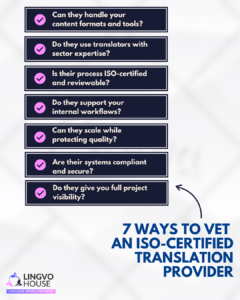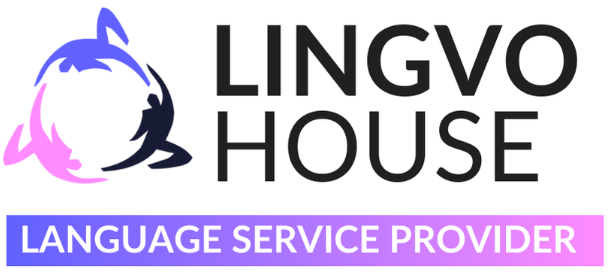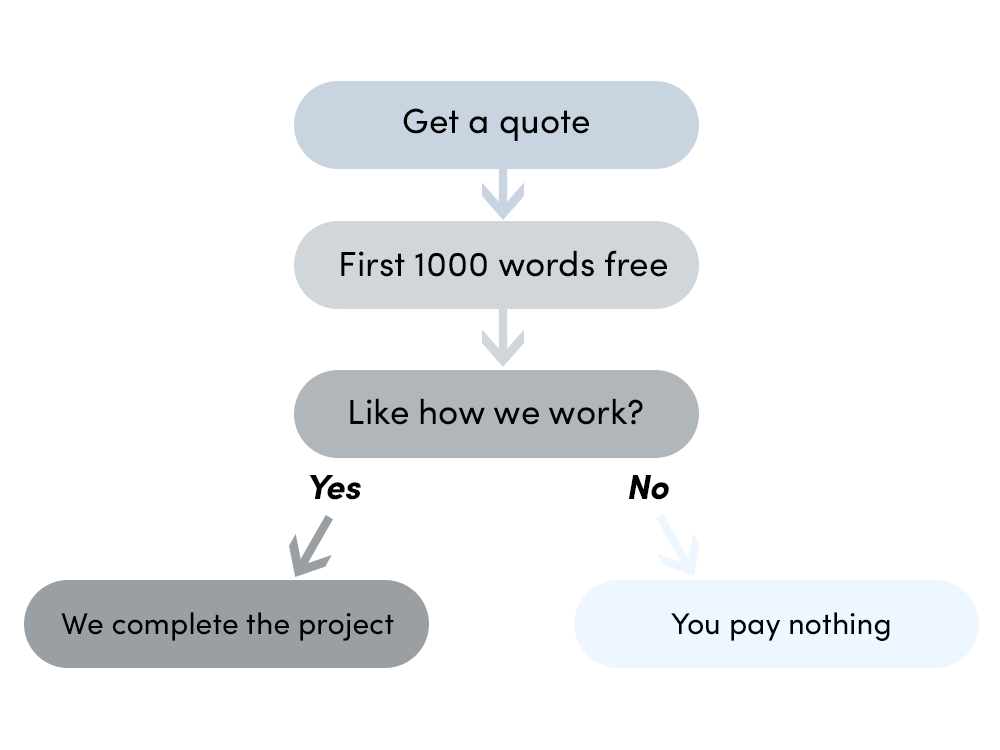When procurement teams first encounter the world of Language Service Providers (LSPs), they often underestimate the complexity. What seems like a straightforward translation purchase can quickly become a strategic sourcing challenge with significant business implications. Here’s what procurement professionals need to know about navigating this specialised market.
Why LSPs Are More Than Translation Companies
 The term “Language Service Provider” might sound like corporate jargon, but it reflects an important reality. Today’s LSPs are sophisticated technology and service companies that happen to specialise in multilingual content. They’re more akin to specialised consulting firms with deep technical capabilities than traditional translation shops. The global language services market exceeds $60 billion annually and continues growing rapidly. This growth is driven by global business expansion, increasingly complex regulatory requirements, and a growing recognition that translation errors carry serious business consequences. Consider the pharmaceutical company that faced a three-month regulatory delay due to poorly translated safety documentation, or the financial services firm that triggered a compliance investigation over mistranslated disclosure requirements. These aren’t isolated incidents – they represent the hidden costs of treating language services as a commodity purchase.
The term “Language Service Provider” might sound like corporate jargon, but it reflects an important reality. Today’s LSPs are sophisticated technology and service companies that happen to specialise in multilingual content. They’re more akin to specialised consulting firms with deep technical capabilities than traditional translation shops. The global language services market exceeds $60 billion annually and continues growing rapidly. This growth is driven by global business expansion, increasingly complex regulatory requirements, and a growing recognition that translation errors carry serious business consequences. Consider the pharmaceutical company that faced a three-month regulatory delay due to poorly translated safety documentation, or the financial services firm that triggered a compliance investigation over mistranslated disclosure requirements. These aren’t isolated incidents – they represent the hidden costs of treating language services as a commodity purchase.
Understanding the LSP Landscape
The language services market is remarkably fragmented, with providers ranging from global enterprises to specialised boutiques. This fragmentation creates both opportunities and challenges for procurement teams.
Global enterprise LSPs offer comprehensive solutions across dozens of languages, sophisticated technology platforms, and the capacity to handle massive volumes. They excel at providing consistency across large, complex programs and typically offer the most robust project management capabilities.
Regional specialists often deliver superior service and competitive pricing for specific language pairs or geographic markets. Their deep understanding of local regulatory environments and cultural nuances can be invaluable for market-specific content.
Industry specialists represent perhaps the most interesting category. These smaller firms have developed deep expertise in specific sectors like life sciences, financial services, or legal translation. While they may cost more per word, their specialised knowledge often delivers better outcomes for technical content.
The key insight for procurement teams: there’s no universal solution. Successful sourcing strategies align provider capabilities with specific organisational needs and risk tolerances.
Why Technical Translation Demands Different Procurement Approaches
Most procurement professionals initially approach translation services like any other category – identify requirements, run a competitive process, and select the lowest-cost qualified provider. But technical translation operates under different rules. When dealing with regulatory submissions, safety documentation, or compliance materials, translation accuracy becomes a business-critical requirement. A single incorrect term in a clinical trial report can delay product launches by months. Mistranslated financial disclosures can trigger regulatory investigations. Poor quality control in safety documentation can create liability issues. These elevated stakes fundamentally change the procurement equation. Price becomes secondary to accuracy and reliability. Speed matters, but not at the expense of quality. Suddenly, procurement teams need to evaluate factors like subject matter expertise, quality assurance processes, and risk management capabilities.
7 Things to Look for in an ISO-Certified Translation Provider for Compliance Documents
When you’re dealing with compliance documentation, choosing the wrong translation provider can be costly and inconvenient. Regulatory delays, failed audits, and compliance violations all trace back to translation errors that could have been prevented. Here’s what matters when evaluating LSPs for your most critical content.

1. Can They Handle Your File Types Without Breaking Things?
This sounds basic, but you’d be surprised how often it goes wrong. Your compliance documents probably live in XML files, structured InDesign layouts, or specialized CMS platforms. The LSP needs to work with these formats directly, and not convert everything to Word and hope for the best. Look for providers who can demonstrate actual experience with your specific file types. Ask them to walk you through their process. Do they have dedicated technical teams? Can they handle complex formatting without losing critical information? Have they worked with your particular CMS or authoring tools before? The best providers will show you examples of similar work and explain exactly how they maintain formatting integrity throughout the translation process.
2. Do Their Translators Know Your Industry?
Here’s where many organizations make expensive mistakes. Fluency in two languages doesn’t automatically qualify someone to translate pharmaceutical submission documents or financial compliance reports. These documents are packed with specialised terminology and regulatory concepts that generalist translators simply don’t understand. What you want to see: translators with actual industry experience, not just language skills. Ask for translator CVs. Look for relevant educational backgrounds, professional certifications, and years of experience in your specific sector. The best LSPs maintain pools of subject matter experts who understand both the language and the regulatory environment. Don’t be afraid to ask tough questions: How do they test translator knowledge? What’s their ongoing training process? Can they provide examples of similar documents they’ve translated successfully?
3. How Thorough Is Their Quality Control Process?
Every LSP talks about quality, but what does that mean? For compliance documents, you need multiple layers of review, consistent terminology management, and documented quality metrics. ISO 17100 certification is your starting point – it ensures standardised translation processes. But dig deeper. How many people review each translation? Is there a subject matter expert involved in the review process? How do they handle terminology consistency across multiple documents? The sophisticated providers will show you their actual quality workflows, explain their error tracking systems, and provide quality metrics from similar projects. They should be able to demonstrate continuous improvement processes and explain how they prevent the same errors from recurring.
4. Can They Work with Your Internal Review Process?
Most compliance documents need internal review before finalisation. The LSP should make this easy, not painful. Look for providers who offer reviewer portals, collaborative commenting tools, and flexible workflows that accommodate your team’s preferences. Ask about version control – how do they track changes and manage feedback? Can they integrate with your existing review tools? Do they provide training for your internal reviewers? The best providers treat internal review as a partnership, not an obstacle.
5. What Happens When You Need Everything Done Yesterday?
Compliance work often involves tight deadlines: audit responses, regulatory submissions, and emergency documentation updates. Your LSP needs to handle sudden volume spikes without compromising quality. Look for providers with backup translator pools, dedicated project managers, and clear capacity planning processes. Ask specific questions: What’s their largest project in the last year? How do they handle conflicting deadlines? Do they have resources available across different time zones? The right provider will have systems in place to scale quickly while maintaining their quality standards. They should be able to show you examples of how they’ve handled similar situations.
6. Are They Serious About Security and Compliance?
This isn’t negotiable. Your compliance documents contain sensitive information that requires protection. The LSP must demonstrate robust security practices, not just talk about them. ISO 27001 certification for information security is essential. GDPR compliance is mandatory for any EU-related content. Depending on your industry, you might need additional certifications like TISAX for automotive or specific healthcare data protection standards. But certifications are just the beginning. Ask about their actual security practices: How do they transfer files? Where is the data stored? What are their data retention policies? How do they handle confidentiality agreements? The best providers will welcome these questions and provide detailed documentation.
7. Do You Know What’s Happening with Your Projects?
Translation projects can feel like black boxes – you send documents in and hope they come back correctly. For compliance work, you need visibility and control throughout the process. Look for providers who offer project dashboards, regular progress updates, and detailed reporting. You should always know where your project stands, what issues have emerged, and what the timeline looks like. The best providers proactively communicate potential problems and propose solutions. Ask to see their project management systems. How do they track progress? What kind of reporting do they provide? How quickly do they escalate issues? Good LSPs treat transparency as a competitive advantage.
Why This Matters More Than You Think
Compliance documentation isn’t just another translation project. These documents directly impact your ability to operate in international markets, meet regulatory requirements, and maintain business continuity. Getting them wrong can trigger regulatory investigations, delay product launches, or create legal liabilities. The best LSPs understand these stakes and structure their entire operation around accuracy, consistency, and reliability. They invest in specialised expertise, robust quality processes, and secure infrastructure because they know that for compliance work, being good enough isn’t good enough. When evaluating providers, remember that the cheapest option is rarely the best value. Focus on finding partners who understand your industry, demonstrate proven processes, and can scale with your needs while maintaining quality standards.
Optimising the RFP Process
Successful LSP procurement requires a different approach to the RFP process. Traditional procurement methods often miss critical factors that determine project success.
Lead with Use Cases, Not Technical Requirements
Instead of starting with “We need German translation services,” begin with “We need to submit regulatory documentation to German authorities within tight deadlines while maintaining perfect accuracy.” Use cases drive everything else about the engagement and help suppliers understand the business context.
Include Practical Assessments
Don’t rely solely on presentations and references. Provide actual content samples for translation as part of the evaluation process. A 500-word test translation reveals more about capabilities than hours of vendor presentations. This approach also gives internal stakeholders a chance to evaluate quality firsthand.
Understand Capacity Models and Scalability
Capacity management separates sophisticated LSPs from basic providers. How do they handle surge requirements? What happens when volume suddenly triples due to a product launch or audit response? Understanding their resource model reveals operational sophistication and helps predict performance under pressure.
Evaluate Technology Strategy
The language services industry is being transformed by artificial intelligence and automation technologies. Forward-thinking LSPs are investing in technology to improve quality and efficiency, not just reduce costs. Procurement teams should understand each provider’s technology roadmap and their approach to innovation.
Effective Vendor Management Strategies
LSP relationships require more active management than typical vendor partnerships. The collaborative nature of translation work and the importance of consistency over time demand ongoing attention.
Performance Metrics Beyond Cost and Speed
On-time delivery and cost per word are obvious metrics, but they’re insufficient for managing translation relationships. Quality scores, revision rates, and internal customer satisfaction provide better indicators of partnership health. The best LSPs provide detailed analytics across all performance dimensions.
Structured Communication and Review Processes
Successful LSP relationships benefit from regular touchpoints: monthly operational reviews, quarterly business reviews, and annual strategic planning sessions. These are opportunities to optimise processes, address emerging challenges, and explore new capabilities.
Continuous Improvement and Innovation
The language services industry evolves rapidly, driven by technological advancement and changing client needs. Strong LSP partners should regularly propose process improvements, cost optimisation opportunities, and new service capabilities. If they’re not bringing new ideas, the partnership may need reevaluation.
The Impact of AI and Automation

Artificial intelligence is transforming the language services industry, but not in ways most people expect. While machine translation capabilities continue improving, human expertise remains essential for technical content requiring accuracy and nuance. The most sophisticated LSPs use AI to augment human translators rather than replace them. Machine translation provides first drafts, AI tools help with consistency checking, and automation handles routine project management tasks. The result is improved efficiency and quality, not just lower costs. For procurement teams, this means focusing on partners who thoughtfully integrate technology rather than those simply chasing cost reduction. The goal should be better outcomes through intelligent automation, not just cheaper services.
Strategic Sourcing Approaches
Many organisations benefit from hybrid sourcing strategies that balance consistency, expertise, and flexibility:
Primary LSP partnerships handle the majority of volume, providing consistency and relationship depth. These partners understand organisational requirements, maintain project history, and can scale efficiently.
Specialist partnerships cover specific industries or technical domains where expertise matters more than volume. These relationships provide access to deep knowledge in critical areas.
Regional partnerships handle specific language pairs or markets where local providers have advantages in cultural knowledge or regulatory understanding.
Capacity partnerships provide qualified backup resources for surge situations or emergency requirements.
This approach delivers consistency for routine work, expertise for complex projects, and flexibility for changing needs.
The Strategic Imperative
The most important lesson for procurement professionals is that LSP selection represents strategic sourcing, not commodity purchasing. The right language services partner becomes an extension of the organisation, helping navigate global markets, meet compliance requirements, and communicate effectively with international stakeholders. The wrong partner creates compliance risks, damages customer relationships, and ultimately costs far more than any initial savings. Organisations that treat language services as a strategic capability rather than a cost center typically achieve better outcomes across quality, compliance, and cost dimensions.
Moving Forward
As global business complexity continues increasing, the role of language services in organisational success will only grow. Procurement teams that develop sophisticated approaches to LSP selection and management will create competitive advantages for their organisations. The key is understanding that while language services may seem like a simple procurement category, success requires appreciation for the technical complexity, relationship intensity, and strategic importance of effective multilingual communication. Smart procurement teams invest time in understanding the market, thoroughly evaluating partners, and actively managing ongoing relationships. The organisations they support benefit from reduced risk, improved quality, and more effective global operations.
For procurement professionals looking to optimise their language services sourcing, understanding these fundamentals provides the foundation for successful partnerships. The complexity may seem daunting initially, but the business impact of getting it right makes the investment worthwhile. A small step that de-risks the big one: get a quick quote with pricing and schedule assumptions: https://www.lingvohouse.com/quick-quote/


